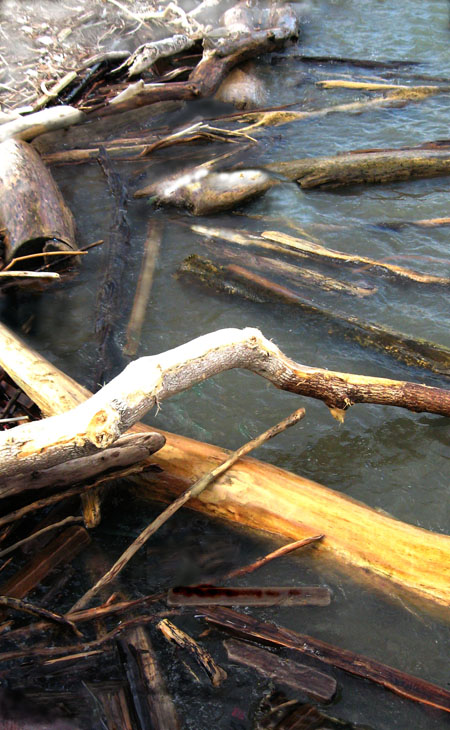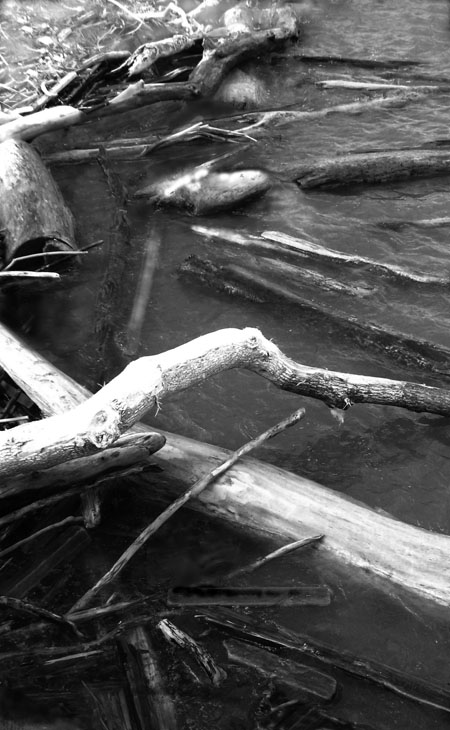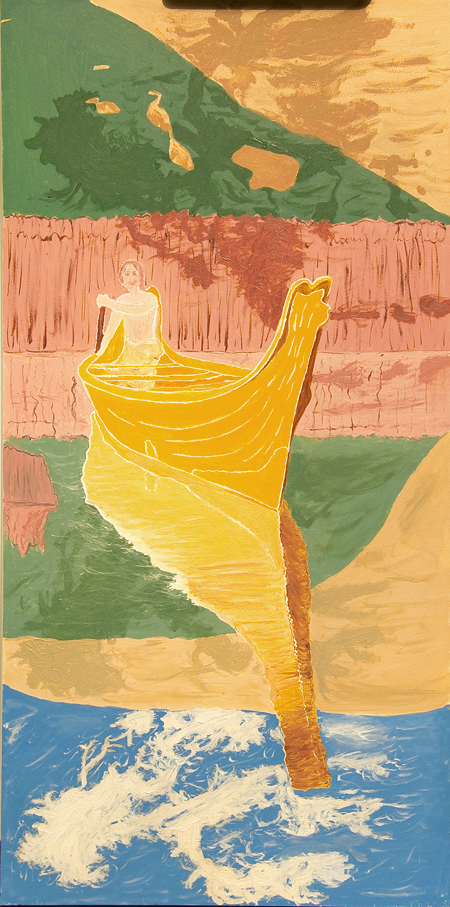Posted by Steve Durbin on May 1st, 2009
Frank Stella famously said “what you see is what you see.” He wanted to stay close to perception and not stray too far into literary or personal interpretations. My title, cribbed from an article in Science, refers not to the invasion of personal emotion, but about the recently experimentally observed influence of literal, tactile touch sensations on visual experience.
Stare at a waterfall long enough, and nearby stationary objects such as rocks and trees will seem to drift up. The optical illusion is called motion aftereffect, and it may trick more than just your eyes, according to a new study. When subjects watched a stationary stripe on a computer screen after a machine stroked their fingertips, the motion of the stroking created the illusion that the stripe was moving. The discovery demonstrates for the first time a two-way crosstalk between touch and vision, challenging long-held notions of how the brain organizes the senses.
I guess the neuroscience of what’s involved here may similar to the sight-sound synaesthesia we’ve discussed before (see comments discussions here and especially here). But this is the first I’ve heard of a tactile version of it. Has anybody out there had experiences along those lines? Other than seeing stars when you bump your head?
Filed in perception
- Tags: perception, synaesthesia
- Comments closed
Posted by Steve Durbin on April 27th, 2009
I drove through parts of Yellowstone a week ago, just a day after the Park (as it’s known locally) opened to automobiles. (I had been hoping to bike in the car-free weeks before that, as I normally do, but the weather was uncooperative.) Despite my regular visits, and posts to this blog, I realized I’ve never shown any photographs of the thermal features for which Yellowstone is justly famous. I have made a few before—surprisingly few—but somehow they never appealed much to me. For some reason I can’t put my finger on, this time felt different, and there are several images I’m willing to publish.

more… »
Filed in landscape,photography
- Tags: landscape, photography, Yellowstone
- Comments closed
Posted by Jay on April 27th, 2009
Whiskey Island, during Prohibition, was a dropping-off point for bootleg from Canada. Those glory days well in the past, the Island, in its backwaters, now tends to collect floating debris. I took this shot over the weekend.


Some time ago, as part of a dialogue with Steve concerning waterfalls, I had reworked an image of a shallow stream stepping over a flat and rocky bed. In touching up the visual I had entered a mild state of flow in which I was aware of my surroundings, but so deeply engrossed in an emerging pattern of alterations that it seemed I was mapping my own mental landscape. Here again I encountered something similar. Time seemed to go away and I lifted my eyes from the screen to find it well past my bedtime. It was a lovely floating experience.
Do you lose track of time when engrossed in your work?
Filed in Uncategorized
- Comments closed
Posted by Angela Ferreira on April 26th, 2009
After being confronted by my husband about the amount of spending on my personal obsessions I decided to share my own extravaganzas: scarves and crystals.
They are all over the house and I collect them incessantly… almost ritually and impulsively. They make me feel good, inspire me and are so irresistible to me! So I am showing just some of them from my collection here.

photo

photo
While words such as “excessive” or “obsessive” might sometimes be used to describe persons with psychological or emotional issues, John Pomara, artist and assistant professor for Arts & Performance, thinks these qualities can be good – for artists.
Read more… Link
I was wondering if any of you have obsessions and would like to share them here on A & P. Would love to hear from your own eccentricities!?!
Filed in being an artist,collecting
- Comments closed
Posted by Birgit Zipser on April 24th, 2009
Having lots to do, I treated myself to a yellow canoe.

12 x 24, oil on board
I had further plans with this picture.
But having lived with it now for two weeks, I am hesitant to change anything. What do you think?
Filed in painting
- Comments closed
Posted by David on April 21st, 2009

Kimono, 2009, acrylic on wood, 48 3/4 x 36 3/4 inches
more… »
Filed in painting
- Comments closed
Posted by June Underwood on April 18th, 2009
As Steve noted not long ago, perception — how, as well as what, we see and record — is prime territory for this group. Some weeks ago I wrote about painting in the desert, the Great Basin to be more precise, and, even more specifically, the Amargosa Plain just outside of Death Valley.
After having spent 6 weeks in the desert, perceiving and painting, mostly plein air, I am now back in Portland reading about desert perception in William L. Fox’s The Void, the Grid, and the Sign.
Fox has spent most of his life in and around a variety of deserts and back-of-nowhere lands, but in The Void he’s primarily concerned with the Great Basin, that large space between the Rockies and the Sierras, where water flows in, but never out, where there is no river coursing to the sea. He says that outside of Afghanistan, this area contains the most mountain ranges (316) in the world, but there are also 90 basins, places where what little water exists is captured between ranges and sinks or evaporates. The best known of these basins is perhaps Death Valley, although that lies outside Fox’s attention. The place I was painting, the Amargosa Plain, is also just outside his wide-ranging travels. However, much of what he says is apropos of the Amargosa and Death Valley.

Death Valley at the Beatty Cut-off, March, 2009
more… »
Filed in art criticism,art history,artform,conceptual,from life,interpretations,landscape,painting,perception,realism,working
- Tags: Basin and Range, perception, plein air, Voids
- Comments closed







